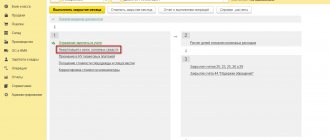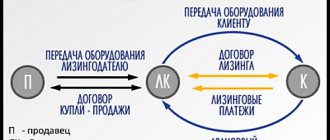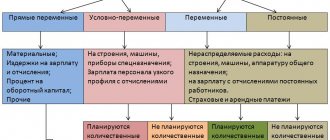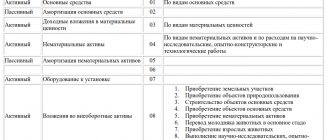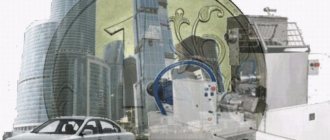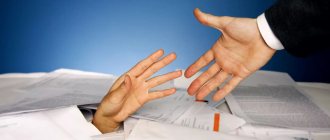Your company has already entered into a leasing agreement and you have questions about how to reflect leasing in accounting? In this article you can find the necessary information and examples of accounting entries for various leasing transactions.
If you are just planning to enter into a leasing transaction and are looking for financing options, you can fill out an application on our website and receive offers from dozens of lessors. Using the site is free, you enter into an agreement directly with the leasing company, which will offer the most favorable conditions.
Accounting for transactions under a leasing agreement is regulated by Order of the Ministry of Finance of the Russian Federation No. 15 dated February 17, 1997.
Leasing transactions depend on whose balance sheet the leased property is reflected in: the lessor or the lessee. The party on whose balance sheet the leased property is accounted for must be indicated in the leasing agreement.
Accounting for leasing when reflecting property on the lessor’s balance sheet
Leasing transactions correspond to the payment schedule located at the link.
If the leasing agreement provides for the reflection of the leased asset on the lessor’s balance sheet, the lessee reflects the leased property on off-balance sheet account 001 “Leased fixed assets”.
The accrual of leasing payments is reflected in the credit of account 76 “Settlements with various debtors and creditors” in correspondence with cost accounts: 20, 23, 25, 26, 29 – when accounting for leasing payments on property that is used in production activities, 44 – on property used in the activities of a trade organization, 91.2 - for property that is used for non-production purposes. Further, for simplicity, in the leasing accounting examples, only entries for the 20th account will be given.
If the leased asset is recorded on the lessor’s balance sheet
Depending on the procedure for accounting for leased property, the accounting procedure for leasing operations is determined, the payer of the property tax is determined, and the inclusion of the leased asset in depreciable property for income tax purposes is determined.
Accounting. The procedure for reflecting leasing transactions in accounting is regulated by the Instructions on the reflection in accounting of transactions under a leasing agreement, approved by Order of the Ministry of Finance of Russia dated February 17, 1997 No. 15 (hereinafter referred to as the Instructions). According to clause 8 of the Directions and Instructions for the application of the Chart of Accounts for accounting the financial and economic activities of an organization, approved by Order of the Ministry of Finance of Russia dated October 31, 2000 No. 94n, if, under the terms of the leasing agreement, the leased property is taken into account on the balance sheet of the lessor, then the cost of the leased property received by the lessee, is taken into account by him on off-balance sheet account 001 “Leased fixed assets” in the amount specified in the leasing agreement, together with VAT.
The transfer of leased property must be formalized in accordance with the requirements for primary accounting documents. Such documents may be an act of acceptance and transfer of fixed assets (unified forms No. OS-1, OS-1a, OS-1b) or a document containing the mandatory details established in clause 2 of Art. 9 of the Federal Law of November 21, 1996 No. 129-FZ “On Accounting”.
In accordance with the Classification of fixed assets included in depreciation groups, approved by Decree of the Government of the Russian Federation dated January 1, 2002 No. 1, leased equipment belongs to the fifth group (including property with a useful life of over 7 years and up to 10 years inclusive).
In accounting, depreciation on an item of fixed assets that is the subject of a leasing agreement is carried out by the party on whose balance sheet, in accordance with the leasing agreement, this object is taken into account. This is indicated by clause 50 of the Methodological Guidelines for Accounting for Fixed Assets, approved by Order of the Ministry of Finance of Russia dated October 13, 2003 No. 91n.
This is what is said in paragraph 50 of the Methodological Guidelines for Accounting for Fixed Assets: “Depreciation on fixed assets that are the subject of a financial lease agreement is carried out by the lessor or the lessee, depending on the terms of the financial lease agreement.” If the property is on the balance sheet of the lessor during the term of the leasing agreement, the accounting of leasing transactions by the lessee is carried out similarly to the accounting of ordinary rental transactions.
Let us recall that the lessee's obligations to pay lease payments begin from the moment the lessee begins using the leased property, unless otherwise provided by the leasing agreement. This position is enshrined in clause 3 of Art. 28 of Law No. 164-FZ. At the same time, the size, method of implementation and frequency of leasing payments in accordance with clause 2 of Art. 28 of Law No. 164-FZ are determined by the terms of the contract. The lessee's accounting records only reflect current lease payments due.
Settlements with the lessor are reflected by the lessee in account 76 “Settlements with various debtors and creditors”, to which the subaccount “Debt on leasing payments” is opened. The amounts of accrued leasing payments based on clause 5 of PBU 10/99 “Expenses of the organization”, approved by Order of the Ministry of Finance of Russia dated May 6, 1999 No. 33n, are included in expenses for ordinary activities. These expenses are recognized in the reporting period in which they occurred, regardless of the time of actual payment of funds and other status of obligations.
Thus, expenses in the form of leasing payments are recognized by the lessee organization in accounting on a monthly basis throughout the entire term of the leasing agreement based on the total amount of leasing payments due under the agreement and the term of the leasing agreement.
If, in accordance with the agreement, the lessee, at his own expense, carries out maintenance, major and current repairs of the leased asset, and ensures its safety, then the amount spent on this is taken into account by the lessee as part of expenses from ordinary activities in the generally established manner.
Postings for current lease payments
Dt 60 – Kt 51 – 236,000 (advance payment (down payment) under the leasing agreement has been paid)
It is necessary to take into account that the advance payment under the leasing agreement can be charged as expenses (offset of the advance payment) not immediately, but throughout the entire agreement. In the above payment schedule, the advance payment under the contract is offset evenly (RUB 6,555.56 each) over 36 months.
Dt 20 – Kt 76 – 29,276.27 (accrued leasing payment No. 1 – 34,546 minus VAT – 5,269.73)
Dt 19 – Kt 76 – 5,269.73 (VAT charged on lease payment No. 1)
Dt 20 – Kt 60 – 5,555.56 (part of the advance payment under the leasing agreement is credited – 6,555.56 minus VAT 1,000)
Dt 19 – Kt 60 – 1,000 (VAT charged against advance payment)
Dt 68 – Kt 19 – 6,269.73 (VAT submitted to the budget)
Dt 76 – Kt 51 – 34,546 (leasing payment No. 1 listed)
The commission that is paid at the beginning of the leasing transaction (commission for concluding the transaction) is charged in accounting to the same expense accounts as current leasing payments.
Postings for the redemption of the leased asset
If there is a buyout price in the leasing agreement (this amount is not included in the leasing payment schedule, for example, let’s take it equal to 1,180 rubles including VAT), the following entries are made in accounting:
Dt 08 – Kt 76 – 1,000 (reflects the costs of purchasing the leased asset when transferring ownership to the lessee)
Dt 19 – Kt 76 – 180 (VAT is charged when purchasing the leased asset)
Dt 68 – Kt 19 – 180 (VAT submitted to the budget)
Dt 76 – Kt 51 – 1,180 (the amount of redemption of the leased asset has been paid)
Dt 01 – Kt 08 – 1,000 (the leased asset is accepted for accounting as part of own fixed assets)
Accounting for leasing when reflecting property on the lessee’s balance sheet
If, under the terms of the leasing agreement, the property is taken into account on the lessee’s balance sheet, upon receipt of the leased asset in the lessee’s accounting, the value of the property minus VAT is reflected in the debit of account 08 “Investments in non-current assets” in correspondence with the credit of account 76 “Settlements with various debtors and creditors”.
When a leased asset is accepted for accounting as part of fixed assets, its value is written off from credit 08 of account to debit 01 of account “Fixed Assets”.
The accrual of leasing payments is reflected in the debit of account 76, subaccount, for example, “Settlements with the lessor” in correspondence with account 76, subaccount, for example, “Settlements for leasing payments”.
Depreciation on the leased asset is calculated by the lessee. The amount of depreciation of the leased asset is recognized as an expense for ordinary activities and is reflected in the debit of account 20 “Main production” in correspondence with the credit of account 02 “Depreciation of fixed assets, subaccount for depreciation of leased property.
Features of leasing accounting and posting
A leasing agreement (LA) is a written agreement between two parties, according to which one party undertakes to purchase property assets at its own expense, and then transfer them for use or temporary possession to the other party. This definition is enshrined in Art. 2 of Law No. 164-FZ of October 29, 1998.
Under the terms of this agreement, it must be determined:
- who will be the owner of the leased object (OL) at the end of the agreement;
- transfer rules, terms and amounts of periodic payments;
- features of the repurchase or return of the leased asset;
- the procedure for paying the redemption price of a property asset under an LD (as part of periodic transfers or at the end of the agreement);
- on whose balance sheet the property assets named in the LD will be listed;
- other.
These conditions are key in determining the order of reflection of standard accounting entries. So, for example, accounting entries for leasing a car from the lessee will depend on whose balance sheet the OL is listed on: for example, leasing entries on the balance sheet of the lessee or on the balance sheet of the lessor organization.
Also, significant differences in accounting lie in the method of reflecting the redemption price of OL. In this case, accounting records are compiled depending on whether the cost is included in the obligatory payments under the contract or not.
Let us note that these features of accounting for leasing operations are typical only for economic entities that have the status of legal entities. For private or individual entrepreneurs there is no obligation to keep records.
Tax accounting of leasing when reflecting property on the lessee’s balance sheet
In the tax accounting of the lessee, leased property is recognized as depreciable property.
The initial cost of the leased asset is determined as the amount of the lessor's expenses for its acquisition.
For profit tax purposes, the monthly depreciation amount is determined based on the product of the original cost of the leased asset and the depreciation rate, which is determined based on the useful life of the leased property (taking into account the classification of fixed assets included in depreciation groups). In this case, the lessee has the right to apply a coefficient of up to 3 to the depreciation rate. The specific size of the increasing coefficient is determined by the lessee in the range from 1 to 3. This coefficient does not apply to leased property belonging to the first to third depreciation groups.
Leasing payments minus the amount of depreciation on leased property are expenses associated with production and sales.
An example of accounting for leasing when reflecting property on the lessee’s balance sheet
Leasing transactions correspond to the payment schedule for property leasing located at the link
The lessee received a passenger car under a leasing agreement, payment schedule parameters:
- leasing agreement term – 3 years (36 months)
- the total amount of payments under the leasing agreement is 1,479,655.10 rubles, incl. VAT – 225,710.10 rubles
- advance payment (down payment) – 20%, 236,000 rubles, incl. VAT – 36,000 rubles
- car cost – 1,180,000 rubles, incl. VAT – 180,000 rubles
The expected period of use of the leased property is four years (48 months). The car belongs to the third depreciation group (property with a useful life of 3 to 5 years). Depreciation is calculated using the straight-line method.
Let's determine the amount of monthly depreciation in accounting. Because the cost of the property (including the leasing company's remuneration) is equal to 1,253,945 rubles (1,479,655.10 - 225,710.10), monthly depreciation will be 1,253,945: 48 = 26,123.85 rubles.
A passenger car belongs to the third depreciation group, therefore, a period of 48 months can be established in tax accounting. The monthly depreciation rate is 2.0833% (1: 48 months x 100%), the monthly depreciation amount is 1,000,000 x 2.0833% = 20,833.33 rubles.
In accordance with paragraph 10 of paragraph 1 of Article 264 of the Tax Code of the Russian Federation, the amount of the lease payment recognized monthly as an expense for profit tax purposes is 8,442.94 rubles (34,546 (lease payment) - 5,269.73 (VAT as part of the lease payment) – 20,833.33 (monthly depreciation in tax accounting)).
Expenses under the leasing agreement are formed monthly in accounting due to depreciation (26,123.85 rubles), in tax accounting - due to depreciation (20,833.33 rubles) and leasing payment (8,442.94 rubles), a total of 29,276 ,27 rubles.
Because in accounting, the amount of expenses over 36 months (the term of the leasing agreement) is less than in tax accounting, this leads to the emergence of taxable temporary differences and deferred tax liabilities.
During the term of the leasing agreement, the lessee has a monthly taxable temporary difference in the amount of 3,152.42 rubles (29,276.27 - 26,123.85) and a corresponding deferred tax liability arises in the amount of 630.48 rubles (3,152.42 x 20% ).
Separately, it is necessary to say about accounting for the advance payment (down payment under the contract) . The following situations are possible:
1. When transferring property for leasing, the lessor provides an invoice for the full amount of the advance (in the given schedule of leasing payments - for 236,000 rubles). In this case, the entire amount of the advance payment minus VAT in tax accounting is recognized as an expense for profit tax purposes.
I would like to note that under the leasing agreement, services are provided throughout the entire contract and the fiscal authorities have no reason to assess compliance with the criteria of paragraph 4, paragraph 2 of Article 40 of the Tax Code of the Russian Federation on the comparability of leasing payments, because individual payments cannot be considered as separate transactions, and the price under a leasing agreement must be analyzed in aggregate for all payments in the agreement.
2. The advance payment under the leasing agreement is offset in equal payments throughout the entire leasing term. In this case, the offset portion of the advance payment is recognized as an expense in tax accounting for profit tax purposes.
In the given example of a leasing payment schedule, it is assumed that an advance invoice is issued to the lessee when the property is leased, i.e. In tax accounting, when transferring property into leasing, expenses in the amount of 200,000 rubles are reflected (the advance payment, which is a leasing payment, is not deducted, since in the first month when transferring property into leasing, it is not yet accrued). At the same time, a taxable temporary difference in the amount of 200,000 rubles and a corresponding deferred tax liability in the amount of 40,000 rubles (200,000 rubles x 20%) arise.
At the end of the leasing agreement, the lessee will continue to accrue monthly depreciation in accounting in the amount of 26,123.85 rubles. There will be no expenses in tax accounting. This will lead to a monthly decrease in deferred tax liabilities in the amount of 5,224.77 rubles (26,123.85 rubles x 20%).
Thus, based on the results of the agreement, the total amount of deferred tax liabilities will be equal to zero:
40,000 (deferred tax liability for the advance payment) + 22,697 (630.48 x 36 – deferred tax liability for current lease payments) – 62,697 (5,224.77 x 12 – reduction of deferred tax liabilities for 12 months of depreciation in the accounting accounting after the end of the leasing agreement).
Leasing transactions on the lessor's balance sheet
Regulates the conduct of accounting operations with property leased by order of the Ministry of Finance of the Russian Federation No. dated February 17, 1997. According to the provisions of this document, an object transferred for use and temporary possession to the lessee remains the property of the lessor, i.e., the company that leased the property throughout the entire term of the agreement. But by agreement of the parties, both the lessor and the lessee can take it into account on the balance sheet; it is important to reflect this fact in the agreement. The accounting of leased objects also depends on it.
In the lessor's accounting, the costs of purchasing assets that are subsequently leased are reflected in the debit of a separate subaccount to the account. 08, and such property is taken into account on the account. 03, as an investment that generates income. Its transfer to the tenant is recorded in the analytical accounting of the account. 03. Accounting support for operations with leased property from the owner will be as follows:
| Operations | D/t | K/t |
| Acquisition of property intended for leasing | 08 | 60 |
| VAT included | 19 | 60 |
| Purchase paid | 60 | 51 |
| The asset is accepted for accounting | 03/1 | 08 |
| Postings for transferred property, which is listed on the lessor’s balance sheet | ||
| The property has been transferred to the tenant | 03/2 | 03/1 |
| The costs associated with the maintenance and transfer of the asset are reflected. The lessor's responsibility remains to accrue depreciation since the asset is on its balance sheet. | 20 | 02, 10, 76 |
| Accounted costs written off | 90 | 20 |
| Accrual of leasing payment (monthly) | 62 | 90 |
| Receipt of payments from the lessee | 51 | 62 |
| VAT charged | 90/3 | 68 |
| VAT paid | 68 | 51 |
| Return of property from the tenant | 03/1 | 03/2 |
| Leasing transactions on the lessee's balance sheet | ||
| Transfer of the object to the tenant | 91/2 | 03/1 |
| The owner's leased property is taken into account off the balance sheet | 011 | |
| Calculation of lease payments | 76 | 91/1 |
| Receipt of payment | 51 | 76 |
| VAT accrued and paid | 91 68 | 68 51 |
| Return of a leased asset with fully repaid value | 03 | 91/1 |
| Return of an object with an outstanding contract value | 03/1 | 76 |
Thus, in most cases, income from rental transactions is considered as sales revenue if the object remains on the balance sheet of the company providing the assets for leasing, and as other income if ownership of the object is transferred to the recipient of the leased property.
Read also: Tax accounting for leasing services
Postings upon receipt of the leased asset
Dt 60 – Kt 51 – 236,000 (advance paid under the leasing agreement)
Dt 08 – Kt 76 (Settlements with the lessor) – 1,253,945 (debt under the leasing agreement is reflected without VAT)
Dt 19 – Kt 76 (Settlements with the lessor) - 225,710.10 (VAT reflected under the leasing agreement)
Dt 01 – Kt 08 – 1 253 945 (a car received under a leasing agreement is accepted for registration)
Dt 76 – Kt 60 – 236,000 (advance paid at the conclusion of the leasing agreement is credited)
Dt 68 (Income tax) – Kt 77 – 40,000 (deferred tax liability reflected)
Dt 68 (VAT) – Kt 19 – 36,000 (VAT submitted on advance payment)
Postings for current lease payments
Dt 20 – Kt 02 – 26,123.85 (depreciation on the car has been calculated)
Dt 76 (Settlements with the lessor) - Kt 76 (Settlements for lease payments) - 34,546 (leasing debt reduced by the amount of the lease payment)
Dt 76 “Calculations for leasing payments” – Kt 51 – 34,546 (leasing payment transferred)
Dt 68 (VAT) – Kt 19 – 5,269.73 (VAT is presented on the current lease payment)
Dt 68 (Income tax) – Kt 77 – 630.48 (deferred tax liability reflected)
Typical entries for displaying leasing transactions with the lessee
| Account Dt | Kt account | Transaction amount, rub. | Wiring Description | A document base |
| If the leased object is shown on the lessor's balance sheet | ||||
| 001 | 710 000,00 | Acceptance of leased property to an off-balance sheet account | Lease agreement, transfer and acceptance certificate | |
| 20 (44) | 76 | 30 000,00 | Monthly accrual of leasing payment | Lease agreement, book. reference-calculation |
| 19 | 76 | 5 400,00 | VAT accrual on leasing payment | Buh. reference-calculation |
| 76 | 51 | 35 400,00 | Lease payment transferred | Bank statement |
| 68 | 19 | 5 400,00 | Deduction of VAT payment | |
| 001 | 710 000,00 | Return of the leased item | Lease agreement, transfer and acceptance certificate | |
| If the leased object is displayed on the lessee’s balance sheet (property on the lessee’s balance sheet) | ||||
| Receiving a leased object | ||||
| 60 | 51 | 250 000,00 | Payment of the advance payment under the leasing agreement | Lease agreement, bank statement |
| 08 | 76 | 1260500,00 | Accrual of debt under a leasing agreement | Lease contract |
| 19 | 76 | 226 890,00 | VAT accrual on leasing payment | Buh. reference-calculation |
| 01 | 08 | 1260500,00 | Commissioning of the leased facility | Lease agreement, transfer and acceptance certificate |
| 76 | 60 | 250 000,00 | Offsetting the advance payment under the leasing agreement | |
| 68 | 77 | 42 372,88 | Tax liability for income tax has been accrued | |
| 68 | 19 | 38 135,59 | VAT accrued on advance payment | |
| Monthly lease payments | ||||
| 20 | 02 | 27 000,00 | Calculation of depreciation on a leasing object | Depreciation statement |
| 76-(lease obligations) | 76-(debt on leasing payments) | 37 000,00 | Reducing the debt under a leasing agreement by the amount of the lease payment | Lease contract |
| 76-(debt on leasing payments) | 51 | 37 000,00 | Transfer of lease payment | Bank statement |
| 68 | 19 | 5 644,07 | VAT accrued on the leasing payment paid | |
| 68 | 77 | 650,00 | The income tax liability resulting from the occurrence of a temporary tax difference has been accrued | |
| End of the leasing agreement | ||||
| 02 | 01 | 27 000,00 | Accrued depreciation for the entire period of operation of the leasing object | Depreciation statement |
| 76 | 01 | 1233500,00 | Write-off of a retired leased asset | Lease contract |
Postings within 12 months after the end of the leasing agreement
Dt 20 – Kt 02 (Depreciation of own fixed assets) – 26,123.85 (depreciation accrued on the car)
Dt 77 – Kt 68 (Income tax) – 5,224.77 (reflected decrease in deferred tax liability)
There is also a method in which the initial cost of the leased asset in accounting is equal to the cost of purchasing a car from the lessor, i.e. coincides with the value in tax accounting. In this case, on account 76, when the property is accepted for accounting, only the debt for the value of the property is reflected.
Leasing payments are accrued monthly on credit 20 of account in correspondence with account 76 in the amount of the difference between accrued depreciation and the amount of the monthly lease payment.
Selecting the most reasonable option for reflecting leased property on the balance sheet of the lessor or lessee, as well as agreeing with the leasing company on the optimal scheme for reflecting leasing payments, is a very complex task that requires good knowledge of the specifics of accounting for leasing operations and the peculiarities of the wording in the leasing agreement and primary documents.
Accounting
Before the leased asset is placed on the balance sheet, the lessor must, in accordance with the general procedure, create expenses for its acquisition on account 08.
The initial cost is formed from the purchase price paid to the supplier of the fixed asset, the costs of delivering the object and bringing it into a condition suitable for use. This is reflected in accounting by the following entries:
Debit 08 Credit 60 (76) – the cost of property acquired for a fee for leasing is taken into account;
Debit 08 Credit 23 (26, 70, 76...) - reflects the costs associated with bringing the property to a state in which it can be transferred to the lessee for use.
Include the cost of paying state duty in the initial cost of the leased item. Do this if the responsibility for registering real estate is assigned to the lessor.
Determine the initial cost of the leased property based on:
- primary accounting documents (invoices, acceptance certificates, etc.);
- any other documents confirming the costs incurred (customs declarations, business travel orders, etc.).
For more information about this, see How to reflect the acquisition of fixed assets for a fee in accounting.
After the value has been formed, the leased asset must be reflected in accounting as a profitable investment in tangible assets in account 03. For the convenience of control over the movement of transaction objects, the lessor has the right to open corresponding sub-accounts to account 03:
- “Property intended for lease”;
- "Property transferred on lease."
Take into account the property intended for leasing in the amount of the cost of its acquisition:
Debit 03 subaccount “Property intended for leasing” Credit 08 – leased property is accepted for accounting as profitable investments in material assets.
The further procedure for accounting for leased property depends on where it is recorded:
- on the lessor's balance sheet;
- or on the balance sheet of the lessee.
Current legislation gives the parties the right to agree on whose balance sheet the leased asset will be accounted for (clause 50 of the Methodological Instructions approved by Order of the Ministry of Finance of Russia dated October 13, 2003 No. 91n).
